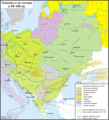Tiedosto:Slav-7-8-obrez.png
Siirry navigaatioon
Siirry hakuun

Tämän esikatselun koko: 544 × 599 kuvapistettä. Muut resoluutiot: 218 × 240 kuvapistettä | 436 × 480 kuvapistettä | 698 × 768 kuvapistettä | 930 × 1 024 kuvapistettä | 1 860 × 2 048 kuvapistettä | 3 051 × 3 359 kuvapistettä.
Alkuperäinen tiedosto (3 051 × 3 359 kuvapistettä, 339 KiB, MIME-tyyppi: image/png)
Tiedoston historia
Päiväystä napsauttamalla näet, millainen tiedosto oli kyseisellä hetkellä.
| Päiväys | Pienoiskuva | Koko | Käyttäjä | Kommentti | |
|---|---|---|---|---|---|
| nykyinen | 12. elokuuta 2023 kello 18.13 |  | 3 051 × 3 359 (339 KiB) | Gyalu22 | Reverted to version as of 13:16, 23 October 2022 (UTC) Look at the atlas, don't do your own research |
| 1. kesäkuuta 2023 kello 20.43 |  | 3 051 × 3 359 (309 KiB) | Shibbolet3579 | enice was still in the Byzantine Empire at this time. Avars were also present around Vienna and in central Transylvania, evidenced by graves & toponyms. There was a linguistic contact between Albanians and Vlachs, evidenced by the non-Slavic words present in both languages. Placed the Etelköz of the Magyars and the Crimean byzantine Greeks. South-Slavic toponyms (as Trnava for "tip, hillock, mound") evidenced a South-Slavic presence in southern Transylvania. Concerning the Eastern romance spe... | |
| 23. lokakuuta 2022 kello 16.16 |  | 3 051 × 3 359 (339 KiB) | Gyalu22 | Reverted bad faith edit, restored to version as of 26 July 2011. The Westermanns Atlas is an irrelevant source for the previous map, as only the Southern Carpathians are shown as possibly inhabited by the Wallachians. | |
| 28. huhtikuuta 2014 kello 18.09 |  | 3 051 × 3 359 (302 KiB) | Spiridon Ion Cepleanu | Bulgarian kingdom & east-romance vlachs according with the universitary atlases of history and the Grosser Atlas zur Weltgeschichte, dir. Hans-Erich Stier, Westermann, 1985, ISBN 3-14-10-0919-8, pp. 50, 55-57, 61 & 64. | |
| 26. heinäkuuta 2011 kello 21.27 |  | 3 051 × 3 359 (339 KiB) | Koryakov Yuri | The map's resolution is drastically decreased. Undo | |
| 26. heinäkuuta 2011 kello 07.53 |  | 544 × 599 (329 KiB) | Spiridon Ion Cepleanu | On the original version of this map, the eastern romance language-spoken populations ("Vlachs" or "Volokhs") are draw only in a little area around Sredets (today Sofia), according with only one of the POVs, called "Röslerian" (since Eduard Robert Rösler | |
| 10. maaliskuuta 2008 kello 16.52 |  | 3 051 × 3 359 (339 KiB) | Koryakov Yuri | {{Information |Description= |Source= self-made |Date=March 2008 |Author= Koryakov Yuri |other_versions= }} == Licensing == {{self|cc-by-sa-3.0}} Category:Maps of the history of Russia in Russian [[Category:Maps |
Tiedoston käyttö
Seuraavat 5 sivua käyttävät tätä tiedostoa:
Tiedoston järjestelmänlaajuinen käyttö
Seuraavat muut wikit käyttävät tätä tiedostoa:
- Käyttö kohteessa ar.wikipedia.org
- Käyttö kohteessa arz.wikipedia.org
- Käyttö kohteessa azb.wikipedia.org
- Käyttö kohteessa ba.wikipedia.org
- Käyttö kohteessa be-tarask.wikipedia.org
- Käyttö kohteessa be.wikipedia.org
- Käyttö kohteessa bg.wikipedia.org
- Käyttö kohteessa ce.wikipedia.org
- Käyttö kohteessa cs.wikipedia.org
- Käyttö kohteessa cv.wikipedia.org
- Käyttö kohteessa da.wikipedia.org
- Käyttö kohteessa de.wikipedia.org
- Käyttö kohteessa en.wikipedia.org
Näytä lisää tämän tiedoston järjestelmänlaajuista käyttöä.


